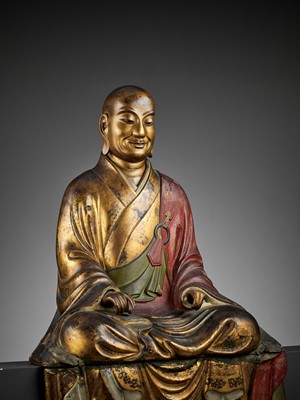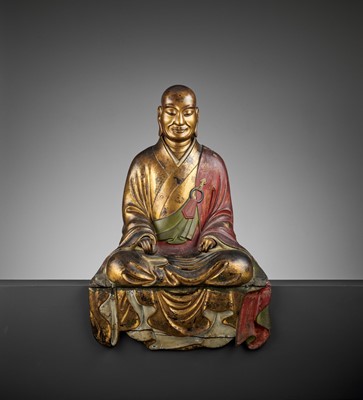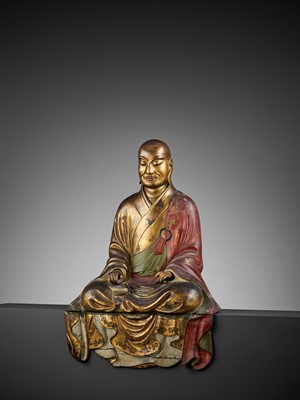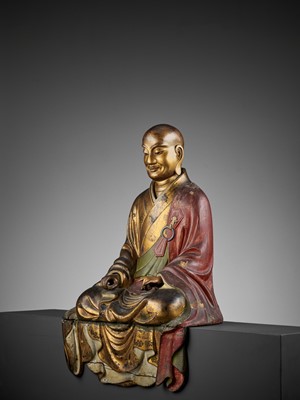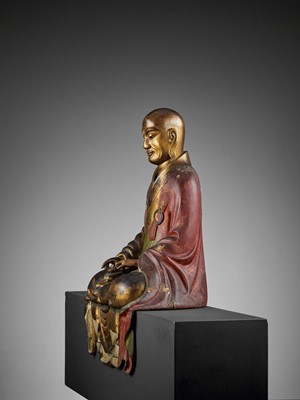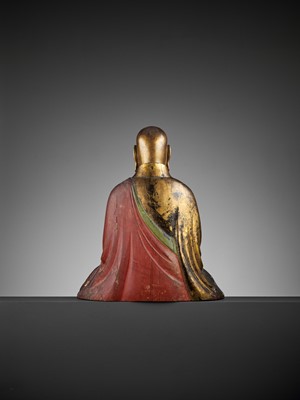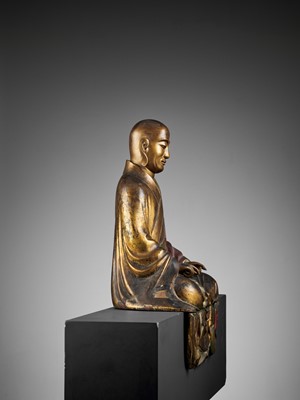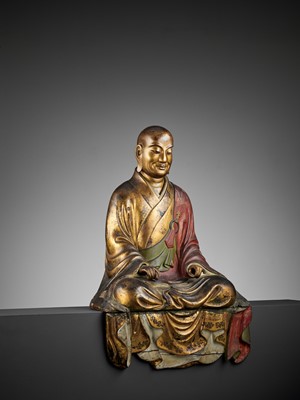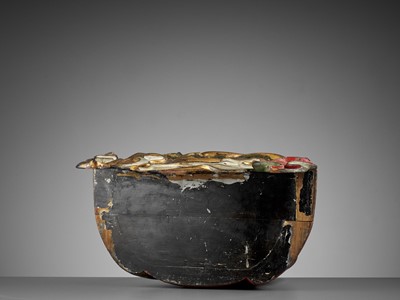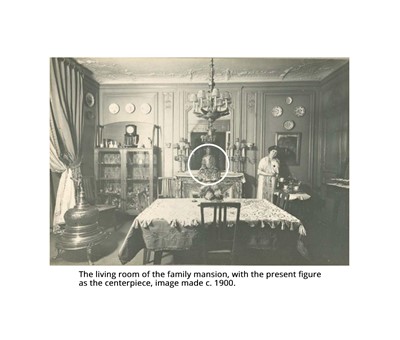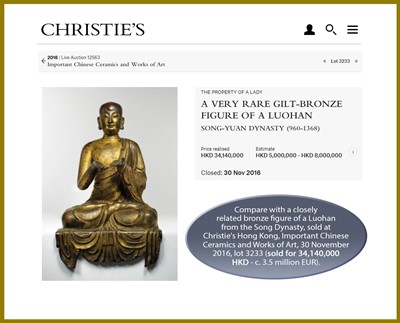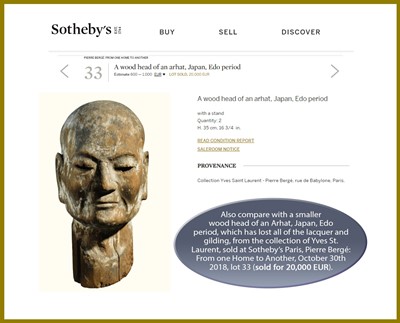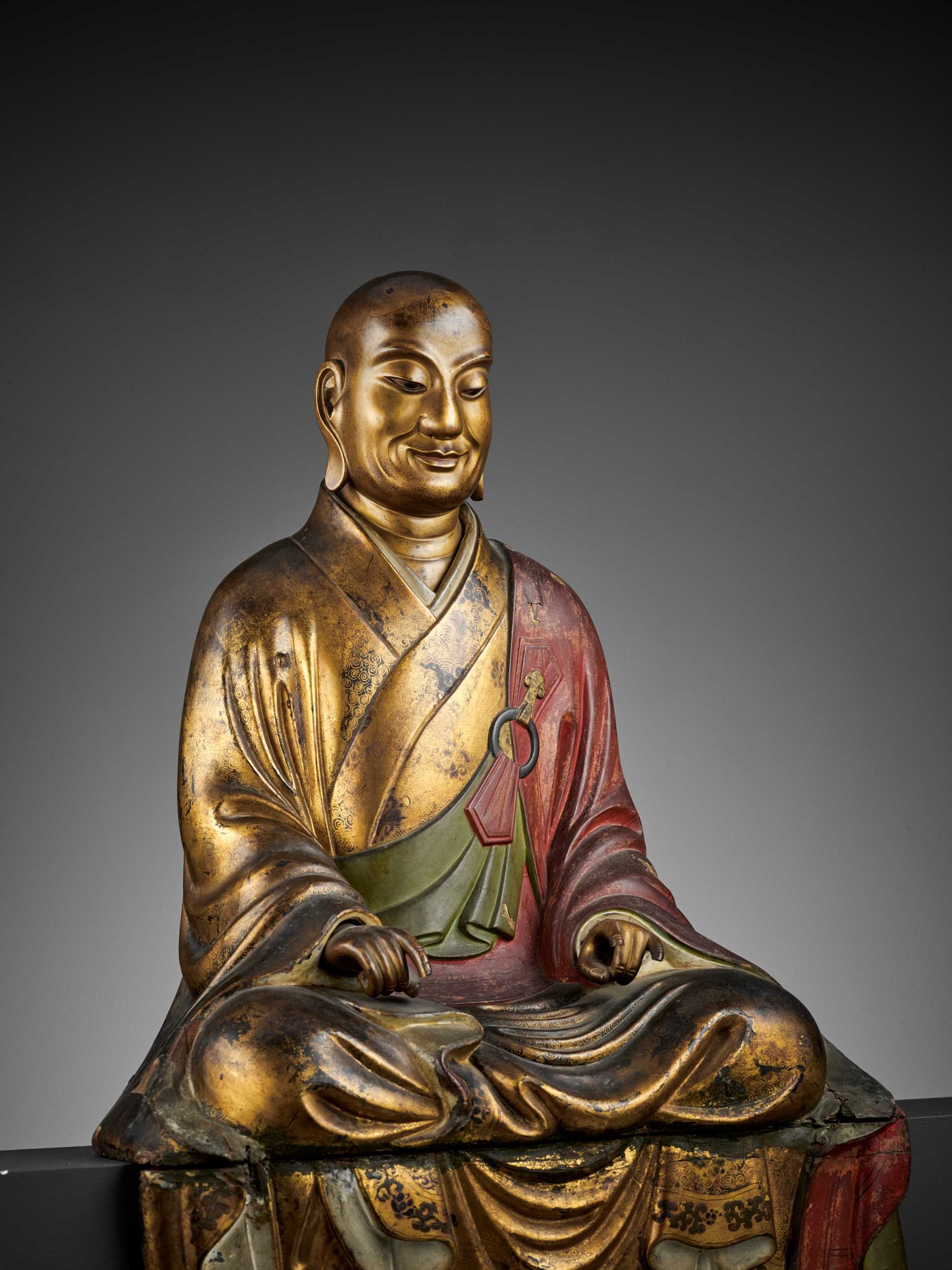4th Jun, 2021 13:00
Fine Japanese Art
126
AN IMPORTANT GILT AND LACQUERED WOOD FIGURE OF A RAKAN
Sold for €101,120
including Buyer's Premium
Japan, 17th – early 18th century, early Edo period (1615-1868)
The graceful, long-waisted figure is shown seated in padmasana, his richly decorated monastic robe worn around his torso, draped over both shoulders and falling in graceful folds below the legs as if draped over an edge, a kesa covering the left shoulder, the neck creased and the slender face well cast with crisp features set in a contemplative expression.
HEIGHT 70 cm
Condition: Traces of use and old wear as expected, some touchups, age cracks and losses. Generally in very good condition, commensurate with age, and better than most lacquered and gilt wood statues of this size and period.
Provenance: Ancient French Private Collection “F”. Thence by descent within the same family. A copy of an image showing the living room of the family mansion, with the present figure as a centerpiece, dating from c. 1900, is accompanying this lot.
Rakan, also known as Luohan in Chinese or Arhat in Sanskrit, is the 'Destroyer of the Passions'. They vary in numbers between 16 and 108 and were depicted in Japanese art from the 8th century onwards.
As Buddha’s apostles, Arhats were first mentioned as sixteen in the Mahayanavataraka which was translated into Chinese in AD 437 and later also into Japanese. A full transcript of these sixteen names was given in AD 653 by the pilgrim monk Xuan Zang with the additional two that were probably adopted by the end of the 10th century, these being the Arhats who tamed the Dragon and the Tiger representing Eastern and Western directions respectively.
There are only few surviving examples of gilt-lacquer figures of Arhats dating to the early Edo period, making the present statue exceptionally rare. The superb carving and imposing style is related to that of two gilt-bronze figures of Luohan dated to the Chinese Song dynasty and sold at Christie’s Hong Kong, 1 October 1991, lot 1668. Another related Chinese figure of a Luohan is illustrated by Hajek, Chinesische Kunst in Tschechoslowakischen Museen, Prague, 1954, no. 115. All of these figures - Japanese and Chinese - share a similarity in the fluid execution of the drapery and the almost portrait-like naturalism of the facial features.
The discovery of some forty clay figures of Luohan at the Lingyan Temple in China, dated to the Song period, but of smaller size, is recorded by Wenwu 1994:3, pages 76-82. In their animated gestures, quality of portraiture and the treatment of the fluid folds of drapery at the front, they also bear resemblance to the present figure.
Auction comparison:
Compare with a closely related bronze figure of a Luohan from the Song Dynasty, sold at Christie's Hong Kong, Important Chinese Ceramics and Works of Art, 30 November 2016, lot 3233 (sold for 34,140,000 HKD - c. 3.5 million EUR). Also compare with a smaller wood head of an Arhat, Japan, Edo period, which has lost all of the lacquer and gilding, from the collection of Yves St. Laurent, sold at Sotheby’s Paris, Pierre Bergé: From one Home to Another, October 30th 2018, lot 33 (sold for 20,000 EUR).
Japan, 17th – early 18th century, early Edo period (1615-1868)
The graceful, long-waisted figure is shown seated in padmasana, his richly decorated monastic robe worn around his torso, draped over both shoulders and falling in graceful folds below the legs as if draped over an edge, a kesa covering the left shoulder, the neck creased and the slender face well cast with crisp features set in a contemplative expression.
HEIGHT 70 cm
Condition: Traces of use and old wear as expected, some touchups, age cracks and losses. Generally in very good condition, commensurate with age, and better than most lacquered and gilt wood statues of this size and period.
Provenance: Ancient French Private Collection “F”. Thence by descent within the same family. A copy of an image showing the living room of the family mansion, with the present figure as a centerpiece, dating from c. 1900, is accompanying this lot.
Rakan, also known as Luohan in Chinese or Arhat in Sanskrit, is the 'Destroyer of the Passions'. They vary in numbers between 16 and 108 and were depicted in Japanese art from the 8th century onwards.
As Buddha’s apostles, Arhats were first mentioned as sixteen in the Mahayanavataraka which was translated into Chinese in AD 437 and later also into Japanese. A full transcript of these sixteen names was given in AD 653 by the pilgrim monk Xuan Zang with the additional two that were probably adopted by the end of the 10th century, these being the Arhats who tamed the Dragon and the Tiger representing Eastern and Western directions respectively.
There are only few surviving examples of gilt-lacquer figures of Arhats dating to the early Edo period, making the present statue exceptionally rare. The superb carving and imposing style is related to that of two gilt-bronze figures of Luohan dated to the Chinese Song dynasty and sold at Christie’s Hong Kong, 1 October 1991, lot 1668. Another related Chinese figure of a Luohan is illustrated by Hajek, Chinesische Kunst in Tschechoslowakischen Museen, Prague, 1954, no. 115. All of these figures - Japanese and Chinese - share a similarity in the fluid execution of the drapery and the almost portrait-like naturalism of the facial features.
The discovery of some forty clay figures of Luohan at the Lingyan Temple in China, dated to the Song period, but of smaller size, is recorded by Wenwu 1994:3, pages 76-82. In their animated gestures, quality of portraiture and the treatment of the fluid folds of drapery at the front, they also bear resemblance to the present figure.
Auction comparison:
Compare with a closely related bronze figure of a Luohan from the Song Dynasty, sold at Christie's Hong Kong, Important Chinese Ceramics and Works of Art, 30 November 2016, lot 3233 (sold for 34,140,000 HKD - c. 3.5 million EUR). Also compare with a smaller wood head of an Arhat, Japan, Edo period, which has lost all of the lacquer and gilding, from the collection of Yves St. Laurent, sold at Sotheby’s Paris, Pierre Bergé: From one Home to Another, October 30th 2018, lot 33 (sold for 20,000 EUR).
Zacke Live Online Bidding
Our online bidding platform makes it easier than ever to bid in our auctions! When you bid through our website, you can take advantage of our premium buyer's terms without incurring any additional online bidding surcharges.
To bid live online, you'll need to create an online account. Once your account is created and your identity is verified, you can register to bid in an auction up to 12 hours before the auction begins.
Intended Spend and Bid Limits
When you register to bid in an online auction, you will need to share your intended maximum spending budget for the auction. We will then review your intended spend and set a bid limit for you. Once you have pre-registered for a live online auction, you can see your intended spend and bid limit by going to 'Account Settings' and clicking on 'Live Bidding Registrations'.
Your bid limit will be the maximum amount you can bid during the auction. Your bid limit is for the hammer price and is not affected by the buyer’s premium and VAT. For example, if you have a bid limit of €1,000 and place two winning bids for €300 and €200, then you will only be able to bid €500 for the rest of the auction. If you try to place a bid that is higher than €500, you will not be able to do so.
Online Absentee and Telephone Bids
You can now leave absentee and telephone bids on our website!
Absentee Bidding
Once you've created an account and your identity is verified, you can leave your absentee bid directly on the lot page. We will contact you when your bids have been confirmed.
Telephone Bidding
Once you've created an account and your identity is verified, you can leave telephone bids online. We will contact you when your bids have been confirmed.
Classic Absentee and Telephone Bidding Form
You can still submit absentee and telephone bids by email or fax if you prefer. Simply fill out the Absentee Bidding/Telephone bidding form and return it to us by email at office@zacke.at or by fax at +43 (1) 532 04 52 20. You can download the PDF from our Upcoming Auctions page.
How-To Guides
How to Create Your Personal Zacke Account
How to Register to Bid on Zacke Live
How to Leave Absentee Bids Online
How to Leave Telephone Bids Online
中文版本的操作指南
创建新账号
注册Zacke Live在线直播竞拍(免平台费)
缺席投标和电话投标
Third-Party Bidding
We partner with best-in-class third-party partners to make it easy for you to bid online in the channel of your choice. Please note that if you bid with one of our third-party online partners, then there will be a live bidding surcharge on top of your final purchase price. You can find all of our fees here. Here's a full list of our third-party partners:
- 51 Bid Live
- EpaiLive
- ArtFoxLive
- Invaluable
- LiveAuctioneers
- the-saleroom
- lot-tissimo
- Drouot
Please note that we place different auctions on different platforms. For example, in general, we only place Chinese art auctions on 51 Bid Live.
Bidding in Person
You must register to bid in person and will be assigned a paddle at the auction. Please contact us at office@zacke.at or +43 (1) 532 04 52 for the latest local health and safety guidelines.
